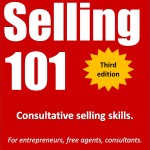Tag Archives: Sales skills training
Buying signals to be alert for –from the prospect’s “gatekeeper” or “screen”
Buying signals from the gatekeeper or screen: What kinds of cues should you be alert for? (“Gatekeeper” and “screen” may apply to anyone from the guard at the gate to the secretary to the personal assistant to the Decision Maker.)
Decision influencers: who they are, and how to work with them
Decision influencers: who are they, and how can you work effectively with them?
Even if the user, or the person in charge of an area, does not have the level of Authority, Need, and Dollars to be the actual Decision Maker, they may nonetheless be an important “Decision Influencer.”
That is, even though this person at this time may be considered a Decision Influencer (because they currently lack some elements of the proper Authority, Need, or Budget Dollars, their ideas, advice and suggestions are listened to with respect.
For example, while they may be the actual users, and hence may have the Need and Authority to sign, nonetheless the necessary budget Dollars (or “sign-off”) reside with their boss, or boss’ boss.
You don’t want to offend them by first seeing them, then appearing to skip over their head.
For instance, if you are selling printers, you may find that the head of the graphics department has the Need for what you offer, but not the Authority or Dollars to allow them to sign the order.
Still, they will be very significant to your maiking that sale, as they are perhaps a key shaper of how that decision goes.
Decision Influencers may include,
Those who will be the actual users of your product or service. That is, the CEO may make the decision on which new “Widget Engine” to buy, but the key influencer of that decision may be Old Joe down on the factory floor who’s worked with every Widget Engine ever sold. Get to Old Joe, win him over, and he can influence the decision your way.
Financial advisors such as the firm’s accountant or Chief Financial Officer: they may say whether or not the firm can afford what you offer, and may also have input on finance alternatives, such as leasing versus purchasing, and the like.
The Decision Maker’s Mentor may play a crucial role in the making of that decision. That is, the person who has Decision Making Authority, Need, and Dollars, may still want to check it with the “old hand” in the company who has helped him along the way. Chances are, you won’t know who that Mentor (or other kinds of covert decision influencers) are, and may never meet them; just be aware there may be one, feeding suggestions, questions and other concerns to the Decision Maker.
The Purchasing Manager may also have a say, though typically more on the technical aspects of how to make the purchase happen within the organization’s policies on purchasing. The fact that the Purchasing Manager may have this kind of influence is a good reason not to antagonize him or her. Go around them to get to the real Decision Maker, but do it quietly and in a nice, unobtrusive way.
Continue reading Decision influencers: who they are, and how to work with them
5 steps in responding to sales objections and questions
Here’s a five-step model approach in responding to objections and questions: Explore, Listen Well, Restate (if appropriate), Respond, then Move on.
1. Explore. Ask questions to get the person talking about what they really mean by the objection, and why it’s important to them. (Why do you feel that way? will do if nothing better comes to mind.)
2. Listen well to their response. You may have heard this objection a dozen times already this week, but this person may put a different twist on it. Don’t be too quick in cutting off the Prospect’s response in order to interject your response. The more you know about the Prospect’s needs and mindset the better you can target your response. Sometimes, the Prospect will actually respond to her own concern, and say something like, Never mind, I think I’ve answered myself. That’s really not so important, after all.
Continue reading 5 steps in responding to sales objections and questions
 Phantom objections: Sometimes an objection seems to relate to one issue, but in fact that issue is cover for a deeper, “phantom” objection.
Phantom objections: Sometimes an objection seems to relate to one issue, but in fact that issue is cover for a deeper, “phantom” objection.